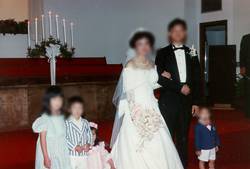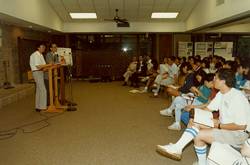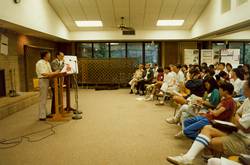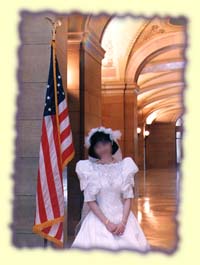 |  |
According to common sense, we should use a flash for indoor photos. It is not necessarily true. Look at the following two photos (because I didn't get a consent of release from the people in the pictures, the following illustration is presented with blurred faces.):
Example 1
 |  |
The picture on the left was taken with a flash. Although the exposure was correct, the flash light created two undesirable effects:
- The background appears to be very dark. When the light emitted from the flash hit the subject and bounced back to the sensor, the flash unit shut off the power and therefore only the foreground, not the background, was illuminated.
- The church was flooded by warm incandescent lamps, but the white light from the flash destroyed the atmosphere.
On the contrary, the photo on the right was taken without a flash. I used a relatively high speed file (ISO 400) and a fast shutter speed. As a result, the picture looks much nicer due to the absence of the above two negative effects.
There is one more example. Look at the two pictures below:
 |  |
In addition to the dark background and white light, there was one more unwanted effect in the left photo: The window reflected the flash and made a very distracting white spot in the picture. Again, the right photo taken without a flash does not have this problem.
Recommendations
When you take indoor pictures,

- do not use a flash if the depth of field is high, or the distance between the subject and the background is very long. You may use a high speed film or ask you subject to stand still to compensate for the slower shutter speed. In the picture on the left, although the bride stood still for a second, the blurring is not noticeable (Her face is blurred in Photoshop due to the absence of the consent of release).
- If you need to use a flash, use a slave unit behind the subject. A slave unit is an additional flash equipped with a light sensor, which can be triggered by the master flash unit. When you fire the master flash, the sensor of the slave receives the light signal and brighten up the background in synchronization with the master.
- If you do not have a slave unit, set the flash to manual. Open the shutter for an additional second. Then the flash will register a clear image while the longer exposure will pick up the background.
- do not use a flash if you want to retain the warm atmosphere created by the yellowish light. If you really want to use a flash and also want to keep the warm atmosphere, put a yellow filter on the flash.
- do not use a flash if there is any reflective surface such as a metal object, a mirror, or a window in front of you. If you absolutely need to use a flash, use a flash with an adjustable head. Point the head to the ceiling so that the light shoots up and then down rather than directly hitting the shiny object. However, this approach works if and only if the ceiling is white and isn't too high.